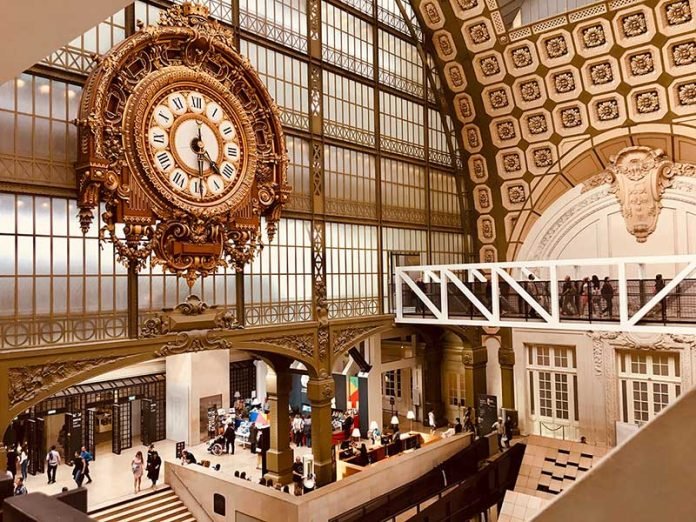Welcome to one of Paris’ monumental canvases where art comes to life – the renowned Musée d’Orsay. Nestled in the heart of Paris, this repository of art is a grand display of history, architecture, and a rich collection of art that spans several centuries. Here is your quintessential guide to immersing yourself in this historical landmark:
History and Architectural Design
The Musée d’Orsay was originally a railway station, Gare d’Orsay, built for the 1900 Exposition Universelle. This Beaux-Arts marvel, designed by Victor Laloux, Lucien Magne, and Émile Bénard, stands as a testament to the architectural ingenuity of the early 20th century, merging both ornate and structural designs.
In 1986, it was reopened as a museum, championing an industrial architectural outlook with a touch of opulence. The grand clock and the sweeping, barrel-vaulted roof are jaw-dropping remnants of its railway station past. Its airy halls and giant clocks offer not just art but a sublime slice of history frozen in time.
Collections On Display
The Musée d’Orsay proudly stands as a repository of a rich diversity of art forms, encapsulating a revolutionary period in the history of art, ranging from 1848 to 1914. The exhibition spaces are designed to carry visitors through a series of chronological and thematic pathways, bringing to life the zeitgeist of the bygone eras through paintings, sculptures, furniture, and photography. Here are some of the categories you can look forward to:
Impressionist and Post-impressionist Masters
The heartbeat of Musée d’Orsay is certainly its unparalleled collection of Impressionist and Post-Impressionist artworks, the largest globally. Here, the intricate details:
Monet and Manet
- Claude Monet: Often regarded as the quintessential impressionist, Monet’s work is a celebration of color and light, with pieces such as “Blue Water Lilies” offering an almost hypnotic array of colors that play with perception and emotion.
- Seasons and Moments: Monet’s series paintings, where he captured the same scene at various moments and seasons, allow one to experience time in a uniquely visual manner.
- Édouard Manet: Manet, on the other hand, played a crucial role in the transition from Realism to Impressionism, bringing a modern perspective to classical subjects.
- Olympia: This provocative painting, which is characterized by a stark break from traditional representation, challenged the contemporary norms of society and art alike.
Van Gogh
- Mental Turmoil and Art: Van Gogh’s short but incredibly productive artistic career was punctuated by personal turmoil, giving birth to some of the most passionate artworks known to mankind.
- Portraits: Aside from his landscapes, his deeply touching portraits provide a window into the souls of his subjects, bringing forth their raw, unfiltered emotions.
- Starry Night over the Rhone: This iconic painting captures a celestial ballet of stars in the night sky with a turbulence that perhaps mirrored his inner world.
Degas and Renoir
- Edgar Degas: Renowned for his stunning representation of ballet dancers, Degas brought forth the grace, dedication, and sometimes the harsh reality behind the beautiful art form through his artworks.
- Movement and Postures: His distinct style captured the dynamism and fluidity of movement with a meticulous attention to posture and anatomy.
- Pierre-Auguste Renoir: Renoir’s canvases echo with a celebration of life, joy, and the beauty inherent in everyday moments, with a particular emphasis on feminine beauty.
- Luncheon of the Boating Party: This masterwork is a lively depiction of a group enjoying a sunny afternoon, a fine example of Renoir’s fascination with light and his mastery in capturing its play on different surfaces.
Gauguin
- Paul Gauguin: Moving away from the naturalism that characterized much of Impressionism, Gauguin embraced bold colors and stark contrasts, creating artworks that were deeply symbolic and emotionally charged.
- French Polynesia: Gauguin’s self-imposed exile in French Polynesia birthed a series of artworks that were a vibrant amalgamation of the exotic landscapes and the deep spiritualism of the native culture.
- Vision After the Sermon: This painting, laden with symbolism, offers a window into Gauguin’s exploration of spiritual themes and the intertwining of reality and vision.
Sculpture
The sculpture collection at the Musée d’Orsay is not just an assemblage of artworks but an immersive experience that awaits to transport visitors to different worlds, crafted meticulously by renowned sculptors of their time. As you step into the grand halls, prepare to be welcomed by a symphony of forms, textures, and emotions, converging classic and modern ideologies through a spectrum of artistic brilliance. Let’s unravel the detailed nuances of this diverse collection:
Rodin
The sections dedicated to Rodin offers a deep dive into the mind of a genius, where stone transcends its material bounds to encapsulate a cosmos of human experiences:
- The Age of Bronze: Initially perceived as so life-like that Rodin faced accusations of having cast the sculpture from a living model, this masterpiece stands testament to Rodin’s intricate understanding of the human anatomy and his unmatched craftsmanship. It portrays a man awakening, a theme of emerging consciousness that draws visitors into a contemplative space.
- The Gates of Hell: An epic creation that captures the vivid imagination and intricate detailing of Dante’s Inferno. This monumental work is a portal into a dramatic world filled with despair, agony, and haunting beauty, offering a narrative through myriad figures each telling a different story, a testimony to Rodin’s narrative brilliance.
- Personal Touch: As you observe, you will find that Rodin’s work often maintains a rough texture, showcasing a raw, unfinished quality that brings a certain vibrancy and immediacy to his sculptures, inviting viewers to a closer, more intimate appreciation of his artistic process.
Maillol
In contrast, Maillol’s creations offer a celebration of form, imbued with a tranquility that speaks of harmony and balanced proportions:
- Female Form: Maillol’s reverence for the female form comes alive through his sculptures that embody grace, strength, and vitality, capturing an eternal femininity that is both nurturing and empowering.
- Harmony: Through the harmonious and fluid lines, he crafted a language of sculpture that speaks of tranquility and sensual simplicity, which can be observed in works like “Mediterranean,” a visual treatise on harmony and form.
- Serenity and Volume: His works offer a study in volume and mass, yet maintain an elemental serenity, inviting viewers to a quiet contemplation, offering a silent dialogue between the art and the beholder.
Camille Claudel
Camille Claudel’s corner in the museum offers a journey through the emotional depth and technical brilliance of a remarkably talented artist:
- Emotion in Material: Claudel’s work often navigates deep emotional landscapes, turning rigid materials into fluid representations of feelings, struggles, and intimate moments, as seen in works such as “The Waltz” and “The Mature Age.”
- Collaboration and Influence: While visiting, one may notice the profound influence of her mentor and collaborator, Auguste Rodin, yet Claudel maintains a distinctive voice, bringing a feminine sensitivity and an innate understanding of human vulnerability to her creations.
- Tragic Muse: Claudel’s life story, one marked with passion, genius, and a tragic end, seems to echo in her creations, offering a haunting yet beautiful testimony to her spirit and her undying passion for her art, making her section one of the deeply moving parts of the sculpture gallery.
Decorative Arts
The Musée d’Orsay’s decorative arts collection stands as a veritable encyclopaedia of style and artistic embellishments that have adorned interiors across centuries. It narrates history not through the grand narratives of battles and kings but through the eloquence of everyday objects, showcasing the aesthetic preferences and the artisanal innovations of different epochs. Here, visitors can meander through rooms that echo with the whispers of history, as told through meticulously crafted objects. Let’s walk through the galleries, one rich era at a time:
Art Nouveau
In the Art Nouveau section, the spirit of a revolutionary artistic movement comes alive through a vivid collection of daily use objects transformed into works of art:
- Furniture: Experience the beauty of craftsmanship in furniture pieces that transcend their functional roles to become standalone pieces of art, characterized by swirling patterns, and undulating lines inspired by natural forms.
- Glass and Ceramics: The collection showcases a splendid array of glasswork and ceramics, where artists experimented with forms, materials, and techniques to create objects d’art that carry the fluid lines and organic inspirations that define Art Nouveau.
- International Influence: As you explore, notice how the Art Nouveau movement was not just a French phenomenon but had international ramifications, with influences from Belgian, German, and Spanish artistry, creating a rich tapestry of interconnected styles.
Gobelins
As you step into the sections showcasing the Gobelins, you immerse yourself in the world of supreme craftsmanship and aristocratic elegance:
- Tapestries: The heart of this collection is undoubtedly the magnificent tapestries, where each piece tells a story through intricate weaving techniques, resulting in detailed and lush visual narratives that adorned the grand halls of the past.
- Furnishings: Beyond tapestries, the collection extends to exquisite furnishings that echo the grandeur of French palaces and aristocratic homes, including finely crafted furniture, ornate mirrors, and chandeliers that hold stories of magnificent balls and grand ceremonies.
- Royal Connections: The Gobelins manufactory had strong connections to the French royalty, and a walk through this section is akin to walking through the annals of royal history, seen through the lens of the finest craftsmen of the era, guided by the artistic visions of the monarchs who commissioned these pieces.
Thematic Exhibits
The museum’s journey through history is further enriched by thematic exhibits that shed light on specific periods and styles, offering a more focused lens on the decorative arts:
- Second Empire Opulence: This exhibit transports visitors to the period of the Second Empire, showcasing an era defined by its opulence and grandeur, with a rich collection of objects that breathe life into the period’s aesthetic preferences and the luxurious lifestyle of the time.
- Belle Époque Details: Step into the beautiful era – the Belle Époque, where the focus shifts to the intricate and delicate details that marked the art of the period. The collection speaks of a time of optimism and innovation, characterized by elegant designs and a refined taste.
- Evolution of Style: Through these thematic exhibits, visitors can observe the evolution of style and artistic preferences, witnessing the ebb and flow of trends as they traverse from one era to another, offering a rich and immersive narrative of the artistic journey through time.
Pioneering Photography
- Daguerreotypes: As you begin your journey, the early daguerreotypes await to transport you back to the infancy of photographic art, where each image stands as a testament to the early innovations, capturing the world with a raw and unprecedented authenticity.
- Avant-Garde Experiments: Moving forward in time, the collection showcases the groundbreaking experimental works of the early 20th century, where photographers began to explore new realms of expression, breaking away from traditional forms and delving into abstract, surreal, and avant-garde directions, redefining the boundaries of the art form.
- Technological Evolution: As you traverse this section, pay attention to the evolution of techniques and materials, a silent narrative that speaks of the relentless human endeavor for innovation and the continuous journey towards refining the artistic expression through technological advancements.
Photography and Painting
- Artistic Dialogues: The photography collection at the museum beautifully illustrates the intricate dialogue between photography and painting. This period saw a fascinating cross-pollination of ideas and techniques, with photographers drawing inspiration from painters and vice versa, a testimony to a rich artistic synergy that defined the era.
- Mimicry and Contrast: Explore displays where photographs mimic the styles and themes prevalent in contemporary paintings, alongside instances where the lens captures a reality starkly different from the canvases, offering a rich study in contrast, and a deeper understanding of the evolving aesthetics of the period.
- Photographic Portraits: Don’t miss the photographic portraits that echo the depth and nuance of painted portraits, a beautiful amalgamation of art forms where the camera lens strives to capture the soul just like the painter’s brush, creating timeless portraits that speak of the human condition.
Iconic Images
- Captured Zeitgeist: In this segment of the collection, iconic images from renowned photographers of the time take center stage, offering glimpses into moments that defined eras, captured through lenses that bore witness to changing worlds.
- Historical Narratives: Each photograph here tells a story, freezing historical narratives in frames, offering silent yet potent commentaries on the socio-cultural dynamics of the periods they represent, a visual history narrated through carefully curated images.
- Emotional Resonance: Beyond the historical, the images carry emotional narratives, encapsulating human joys, sorrows, hopes, and despairs, a poignant reminder of the emotional resonance of photography, its power to touch hearts, and to narrate stories that transcend geographical and temporal bounds.
Location and Opening Times
- Address: 1 Rue de la Légion d’Honneur, 75007 Paris, France. Nestled on the left bank of the Seine, it stands as a beacon of art and history.
- Getting there: The museum is easily accessible via metro (line 12, Solférino station; RER C, Musée d’Orsay station) or by bus (lines 24, 63, 68, 69, 73, 83, 84, 94).
- Opening Times: The museum usually opens from 9:30 am to 6:00 pm, Tuesday to Sunday, and until 9:45 pm on Thursdays. However, always check the official website for any changes in opening hours or special closures.
- Visitor Tips
- Tickets: It is advisable to purchase tickets online to avoid long queues. Ticket prices can vary, so check the official website for the most current information.
- Guided Tours: Consider taking a guided tour to get a deeper understanding of the exhibits. Audio guides are also available in various languages.
- Amenities: The museum offers amenities like cloakrooms, gift shops, and dining areas to enhance your visit.
- Personal Experience: Take time to soak in the details — the museum’s architectural elegance and the serene views of the Seine from its upper floors are experiences in their own right.



